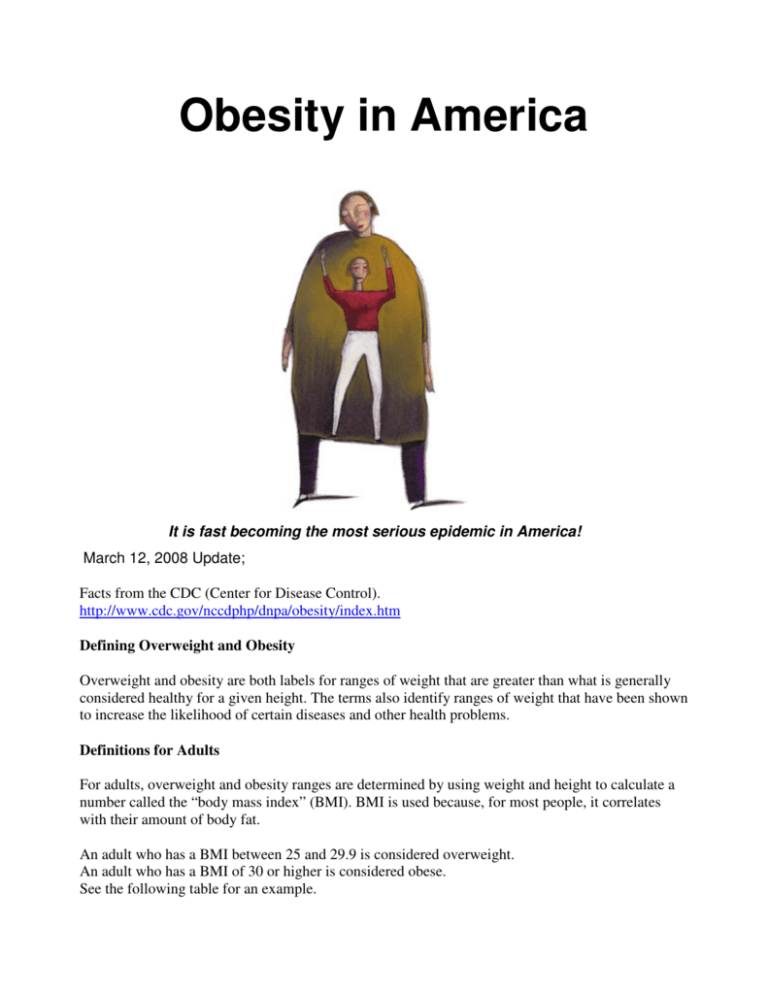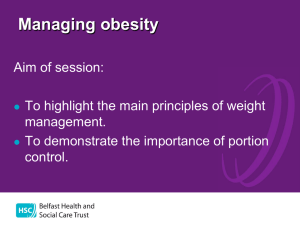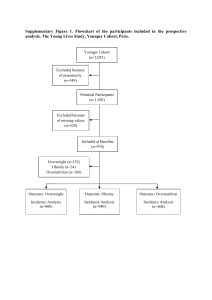Obesity in America
advertisement

Obesity in America It is fast becoming the most serious epidemic in America! March 12, 2008 Update; Facts from the CDC (Center for Disease Control). http://www.cdc.gov/nccdphp/dnpa/obesity/index.htm Defining Overweight and Obesity Overweight and obesity are both labels for ranges of weight that are greater than what is generally considered healthy for a given height. The terms also identify ranges of weight that have been shown to increase the likelihood of certain diseases and other health problems. Definitions for Adults For adults, overweight and obesity ranges are determined by using weight and height to calculate a number called the “body mass index” (BMI). BMI is used because, for most people, it correlates with their amount of body fat. An adult who has a BMI between 25 and 29.9 is considered overweight. An adult who has a BMI of 30 or higher is considered obese. See the following table for an example. Height Weight Range BMI Considered 5’ 9” 124 lbs or less Below 18.5 Underweight 125 lbs to 168 lbs 18.5 to 24.9 Healthy weight 169 lbs to 202 lbs 25.0 to 29.9 Overweight 203 lbs or more 30 or higher Obese It is important to remember that although BMI correlates with the amount of body fat, BMI does not directly measure body fat. As a result, some people, such as athletes, may have a BMI that identifies them as overweight even though they do not have excess body fat. For more information about BMI, visit Body Mass Index. Other methods of estimating body fat and body fat distribution include measurements of skinfold thickness and waist circumference, calculation of waist-to-hip circumference ratios, and techniques such as ultrasound, computed tomography, and magnetic resonance imaging (MRI). Definitions for Children and Teens For children and teens, BMI ranges above a normal weight have different labels (at risk of overweight and overweight). Additionally, BMI ranges for children and teens are defined so that they take into account normal differences in body fat between boys and girls and differences in body fat at various ages. For more information about BMI for children and teens (also called BMI-forage), visit BMI for Children and Teens. Assessing Health Risks Associated with Overweight and Obesity BMI is just one indicator of potential health risks associated with being overweight or obese. For assessing someone’s likelihood of developing overweight- or obesity-related diseases, the National Heart, Lung, and Blood Institute guidelines recommend looking at two other predictors: The individual’s waist circumference (because abdominal fat is a predictor of risk for obesity-related diseases). Other risk factors the individual has for diseases and conditions associated with obesity (for example, high blood pressure or physical inactivity). April 2, 2004 - PMM.com (Updated May 02, 2006) Millions of people from around the world suffer from malnutrition either from not enough food or in this case too much food. It is malnutrition in regards to the ill effects overeating and therefore Obesity has on the human body. If not caught in time, overeating can have detrimental effects on the body leading to many illnesses including but not limited to Diabetes (type II), hypertension (high blood preasure) and heart desiese not to mention the emotional distress. The good news is that in most cases (if not all) this is something that may be prevented by not overeating. Thre is one basic formula to this; Eat Less and Exercise More! As easy as this sounds, many people do not take the necessary steps to do this and therefore we (the United States) are suffering from an epidemic of large proportions (no pun intended). Pmm Fact # 1: America is OVER EATING. Yes, we eat too much, we advertise food too much, and we ignore that overeating is causing detrimental damage and increased healthcare costs. America eats too much Fast Food, which often lacks the necessary nutrients and is high in caloric value. You might save money on fast food, but in the long run, will you really save? Please look through the statistics and judge for yourself: American Obesity Statistics USA Obesity Rates Reach Epidemic Proportions • 58 Million Overweight; 40 Million Obese; 3 Million morbidly Obese • Eight out of 10 over 25's Overweight • 78% of American's not meeting basic activity level recommendations • 25% completely Sedentary • 76% increase in Type II diabetes in adults 30-40 yrs old since 1990 Bar graph from the Oxford Health alliance (click link if interested): http://www.oxha.org/knowledge/backgrounders/overweight_and_obesity.gif/view Obesity Related Diseases • 80% of type II diabetes related to obesity • 70% of Cardiovascular disease related to obesity • 42% breast and colon cancer diagnosed among obese individuals • 30% of gall bladder surgery related to obesity Childhood Obesity Running Out of Control • 4% overweight 1982 | 16% overweight 1994 • 25% of all white children overweight 2001 • 33% African American and Hispanic children overweight 2001 • Hospital costs associated with childhood obesity rising from $35 Million (1979) to $127 Million (1999) Childhood Obesity Running Out of Control • New study suggests one in four overweight children is already showing early signs of type II diabetes (impaired glucose intolerance) Surge in Childhood Diabetes • Between 8% - 45% of newly diagnosed cases of childhood diabetes are type II, associated with obesity. • Whereas 4% of Childhood diabetes was type II in 1990, that number has risen to approximately 20% • Depending on the age group (Type II most frequent 10-19 group) and the racial/ethnic mix of group stated • Of Children diagnosed with Type II diabetes, 85% are obese This research information was prepared by independent authors. It has been reproduced in its entirety or as a collection of information gathered from multiple resources and research data. WIN is not liable for any inaccuracies found in any third party written articles or research. References: National Institute of Diabetes & Digestive & Kidney Diseases (NIDDK) and My.WebMD.com website. COMPLICATIONS OF OBESITY Obesity is not only having too many pounds to carry, that generally makes us feel and look ugly and unattractive but: OBESITY IS A DISEASE that reduces our life span, makes us slow,does not let us move as fast as we should ,which genarally makes us annoyed, criticized and sometimes even attacked. The BOTTOM LINE: It is the the fastest growing epidemic in our country. Like any other DISEASE, there Are ways TO PREVENT IT , and we have been stressing in our Organization that THE BEST MEDICINE IS PREVENTIVE MEDICINE . Why wait until we are sick IF WE CAN PREVENT THE DISEASE from the before it starts! HOW TO PREVENT OBESITY Many of us know the answer to this, but us choose to ignore them: EAT LESS! Count Calories! Excercise More! PMM Fact #2: If you eat less and excercise more, you will shed those pounds! It seems easy to say, but difficult to do it and we most seem to know it. PMM Fact # 2 (again!): if you eat less and excercise more, you will shed those pounds! So, in PREVENTING OBESITY we need to think in the following EQUATION: HOW MUCH WE EAT AND HOW MUCH EXERCISE do WE DO . Physical activities include sports (running,soccer,tennis,football,racket ball,etc.) but also includes simply : WALKING REGULARLY or any physical activity that gets the heart pumping!. So, this EQUATION IS composed of two factors: how much we eat and WHAT WE EAT, plus DO WE DO EXERCISE, and HOW MUCH EXERCISE WE DO DAILY. ASK youself these simple questions an YOU TOO can PREVENT OBESITY! PMM SUGESTION: We can write down what we eat, and approximately how much we eat , and actually we can use tables to determine THE APPROXIMATE AMOUNT OF CALORIES WE EAT on a daily basis, and the approximate AMOUNT OF CALORIES WE SPEND WITH EXERCISING. It is as simple as 1.2.3.! Keep TABS on what you eat. Stay conscious of what you eat, which means, YES, it is probably a good idea to eliminate FAST FOOD from your diet. Not all fast food is bad, but it generally is concerned in getting the food to you fast not your health If concerned, ask the fast food establishment for a calorie chart and try and keep your daily calorie intake LESS than 2,000 Calories. Remember PMM.com fact # 2: EAT LESS and excercise more! http://www.pmmedia.com/obesitypage1.htm








